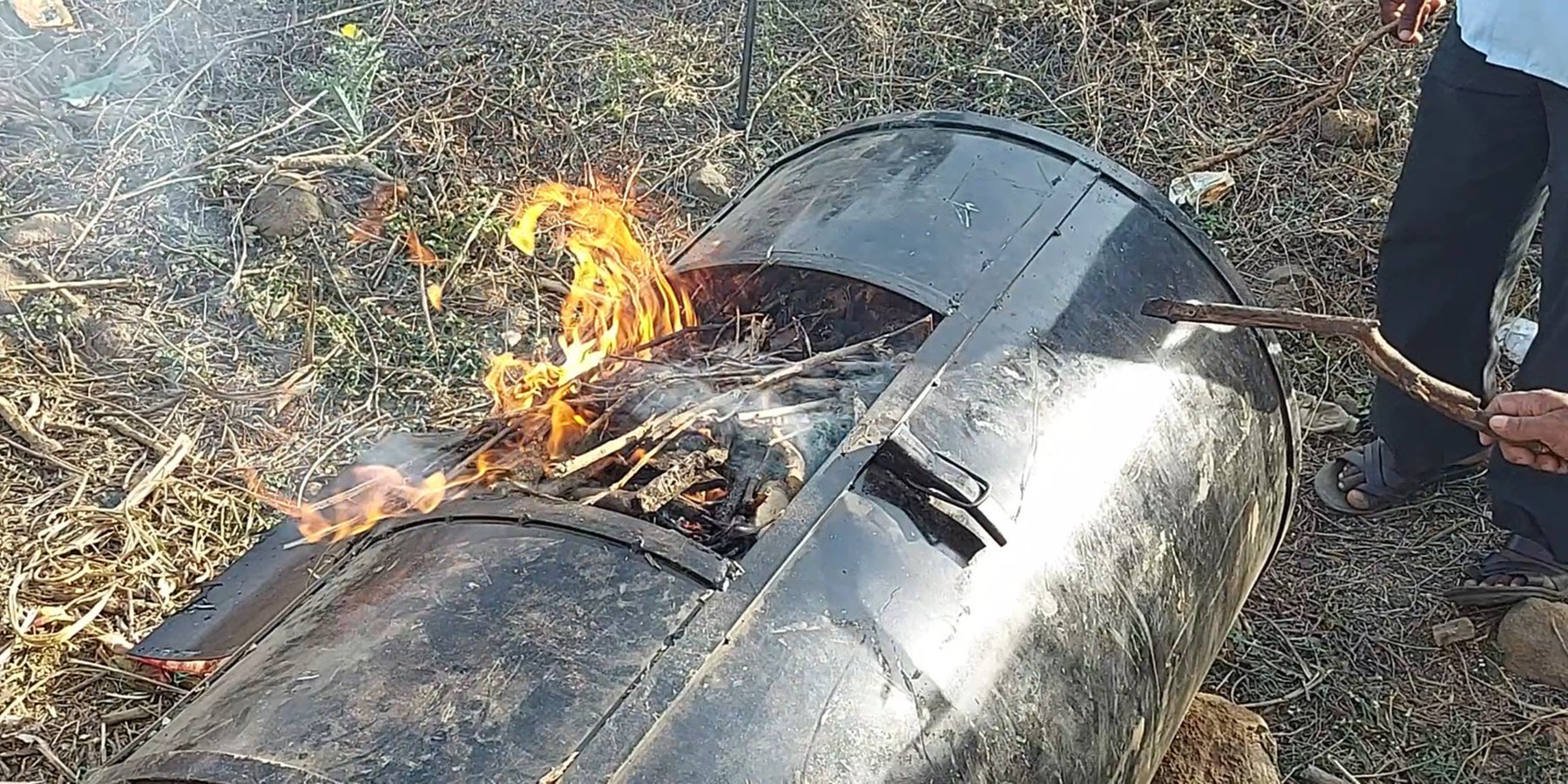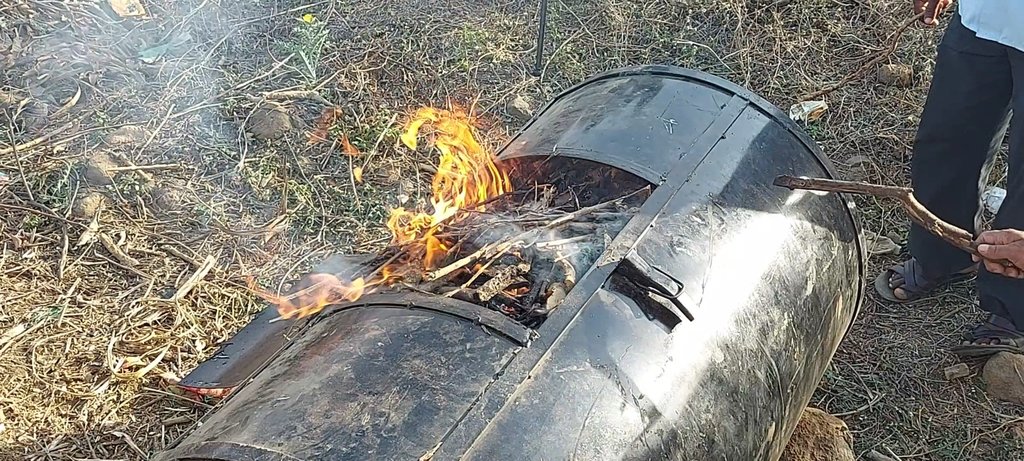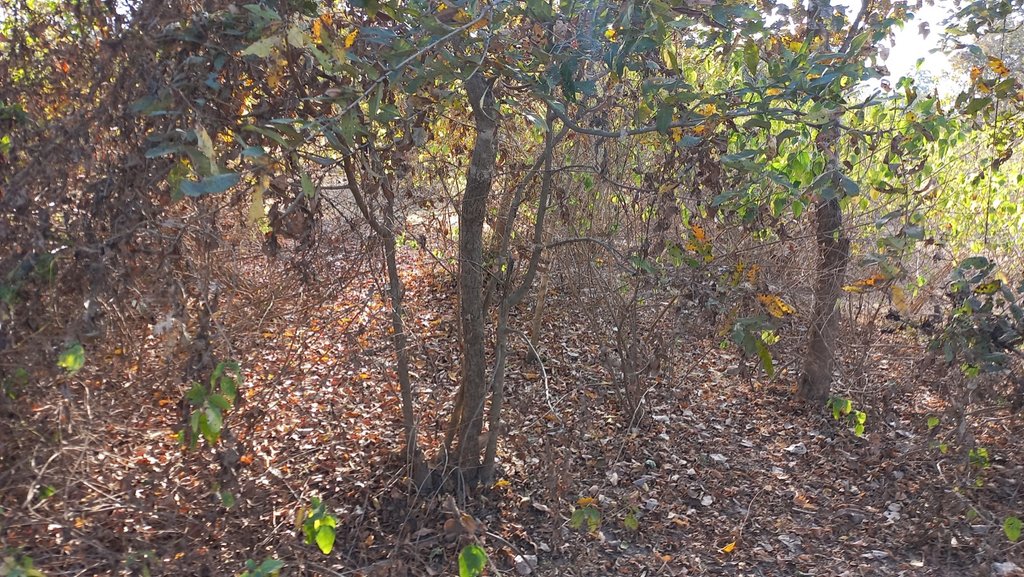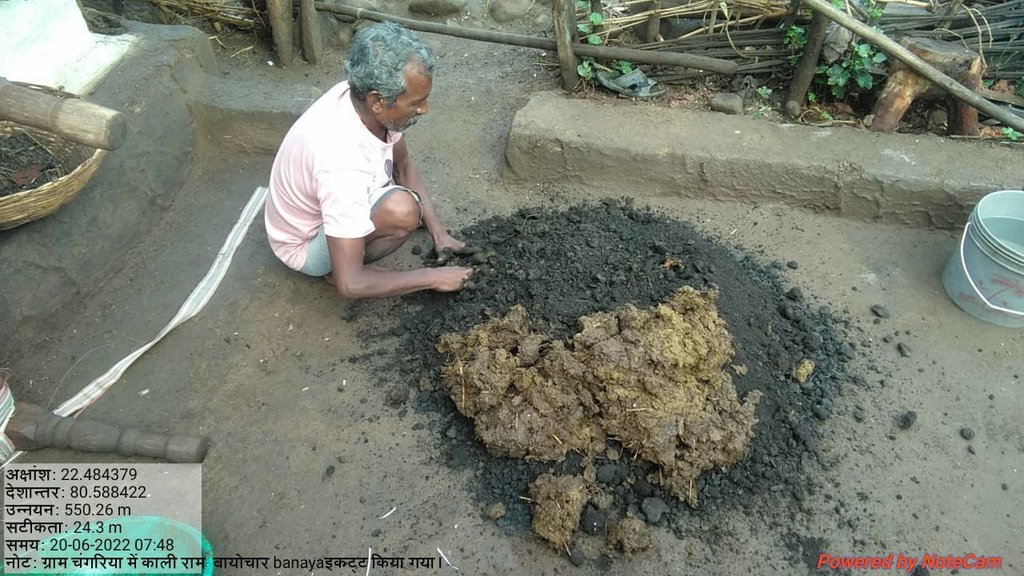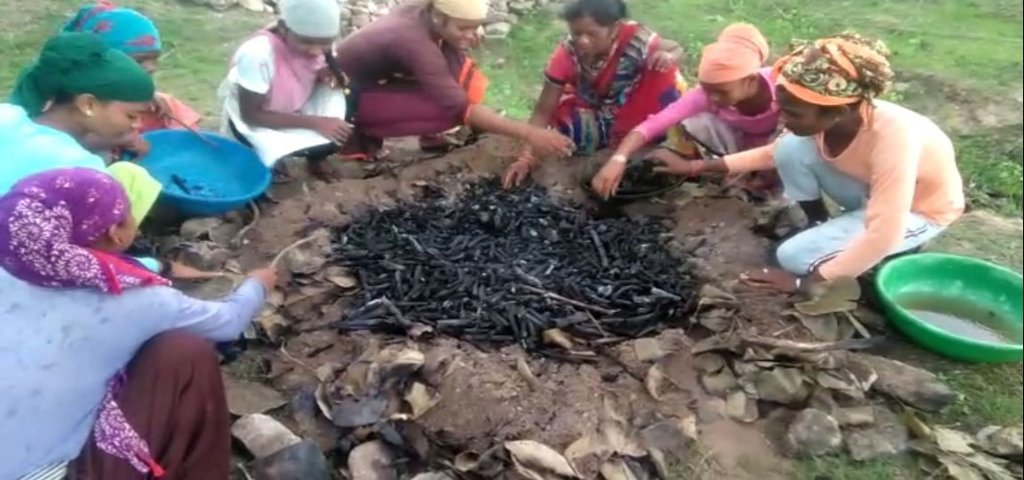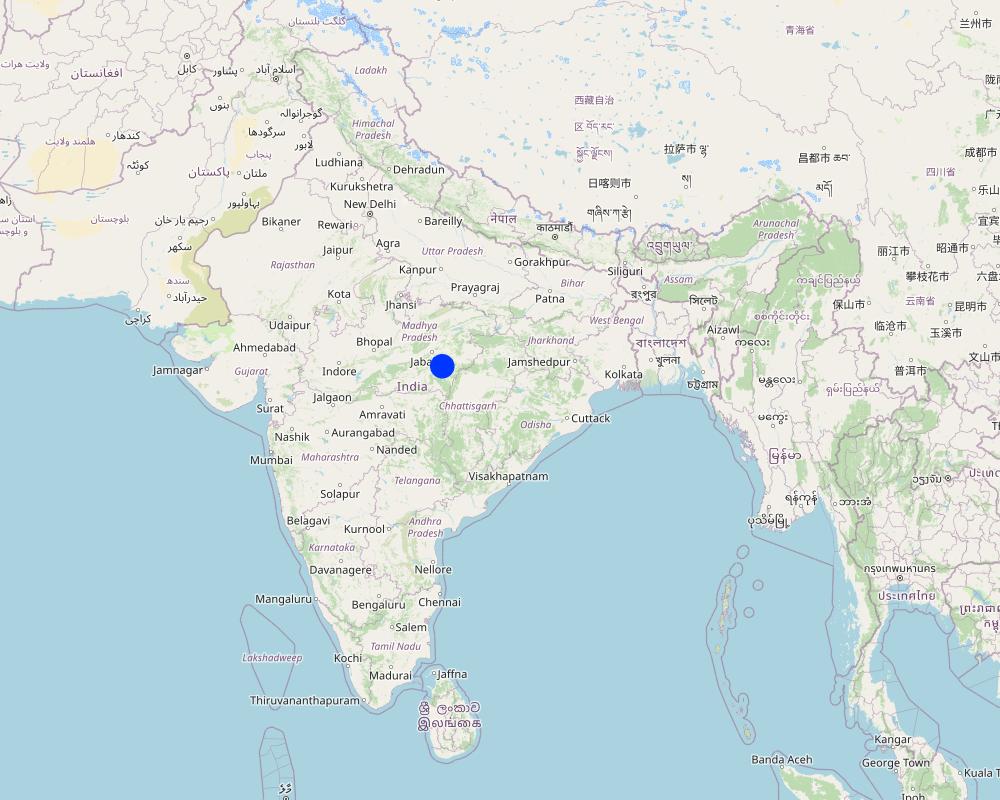Biochar Production from the Invasive Species Lantana Camara [印度]
- 创建:
- 更新:
- 编制者: Santosh Gupta
- 编辑者: Noel Templer, Stephanie Katsir, Kim Arora, Tabitha Nekesa, Ahmadou Gaye, Siagbé Golli
- 审查者: Udo Höggel, Joana Eichenberger, Rima Mekdaschi Studer
technologies_6690 - 印度
查看章节
全部展开 全部收起1. 一般信息
1.2 参与该技术评估和文件编制的资源人员和机构的联系方式
有助于对技术进行记录/评估的项目名称(如相关)
Soil protection and rehabilitation for food security (ProSo(i)l)有助于对技术进行记录/评估的机构名称(如相关)
Deutsche Gesellschaft für Internationale Zusammenarbeit (GIZ) - 德国有助于对技术进行记录/评估的机构名称(如相关)
CIAT International Center for Tropical Agriculture (CIAT International Center for Tropical Agriculture) - 肯尼亚有助于对技术进行记录/评估的机构名称(如相关)
Ecociate Consultants (Ecociate Consultants) - 印度1.3 关于使用通过WOCAT记录的数据的条件
编制者和关键资源人员接受有关使用通过WOCAT记录数据的条件。:
是
1.4 所述技术的可持续性声明
这里所描述的技术在土地退化方面是否存在问题,导致无法被认为是一种可持续的土地管理技术?:
否
注释:
The technology discusses one of the sustainable land management practices that rehabilitate soil health by eradicating invasive species of Lantana Camara and using it to prepare biochar.
2. SLM技术的说明
2.1 技术简介
技术定义:
Lantana Camara, an invasive species in India, negatively impacts biodiversity and agriculture. Biochar made from its biomass can help manage the species effectively. Traditionally farmers produce biochar in soil pit kilns. Another low-cost portable kiln unit of biochar preparation is a viable option for rainfed areas, designed to work on the direct up-draft principle with bottom ignition and circular vents for uniform heat transfer.
2.2 技术的详细说明
说明:
Lantana Camara was introduced into India as an ornamental plant in 1809 by the British in Calcutta Botanical Garden. Lantana Camara negatively impacts biodiversity and native biota, disrupting the succession cycle, altering the structure and floral composition of native communities, and causing problems in agricultural lands in various regions of India. Its dense thickets outcompete native pastures, block the movement of grazers, and can cause poisoning. Its allelopathic activities also affect the growth of other species in its proximity. One of the measures to manage invasive species is by turning it into biochar.
Biochar is the charred biomass produced by slow pyrolysis in which organic material is heated under controlled temperatures (300-500°C) without oxygen. Lantana Camara is an ideal biomass for biochar production due to its high diversity and wide distribution. In addition to protecting ecosystems, invasive plant-derived biochar has potential applications in environmental remediation and soil amendment due to its unique structure, composition, and adsorption properties.
In the Mandla district of Madhya Pradesh, low-cost technologies for producing biochar are being practised. A low-cost portable kiln unit has been used in the Mandla District to cater to the needs of small and marginal farmers. One unit costs approximately Rs. 7000-12000 depending upon the design and location, including a metal drum, vent-making charges, and side fittings. The kiln is designed to work on the direct up-draft principle with bottom ignition. It is a vertical, single-barrel structure with a perforated base. The kiln has a square-shaped loading hole at the top, which can be closed at the end of conversion with a metal lid with a handle. The kiln has circular vents, a staggered arrangement to avoid rows, and a central vent to hold a wooden pole. Under open atmospheric conditions, the vents at the kiln base hasten hot gas movement through the bio-residues for uniform heat transfer by primary air movement. The kiln's top hole vents the released water vapours and hot gases. A strip of metal is welded around at 3/4th height of the kiln, to which two metal rods are welded on opposite sides to serve as lifting jacks. Dry Lantana Camara feedstock is placed inside the kiln unit, and a fire is lit at the bottom. Through a pyrolysis process, the organic compounds present in the biomass decompose at a specific temperature in an oxygen-limited environment.
Prior to use, the stalks/twigs of lantana are manually cut into appropriate pieces 15-19 cm long and 0.9-1.0 cm in diameter using a commonly used axe in order to achieve better packing density. Dry residues are a prerequisite to hasten satisfactory and quicker conversion. The dried residues of lantana are placed in the unit and are burned from the bottom in an oxygen-limited environment. Generally, the burning process takes 6-8 hours through a slow pyrolysis process. Once complete, the kiln is quenched with soil and left to cool for 3-4 hours. This simple and affordable biochar production method can help manage invasive plant species and benefit agriculture, the environment, and energy. The conversion ratio from biomass to biochar in the case of Lantana is around 20-25%. Farmers have reported of burning around 100 kg of dried Lantana biomass to get ~20 kg of biochar in one operation of the unit. The application rate of biochar varies from crop to crop and the type of soil and other characters. In studied project farmers do apply 20 kg of biochar mixed with 20 kg of cow dung and 20 kg of cow urine in an area of around 1 acre.
The burned biomass of Lantana after the process looks like the coal sticks, these sticks are pulverised through a pulveriser to make a powdered material for application in the field. The biochar is mixed with an equal quantity of cow dung and cow urine before the application. Some farmers also mix the native soils in biochar to get better results.
2.3 技术照片
2.4 技术视频
注释、简短说明:
YouTube video accessible at https://youtu.be/MPj4_I5BFRE
2.5 已应用该技术的、本评估所涵盖的国家/地区/地点
国家:
印度
区域/州/省:
Madhya Pradesh
有关地点的进一步说明:
Mandla
具体说明该技术的分布:
- 适用于特定场所/集中在较小区域
技术现场是否位于永久保护区?:
否
注释:
Farmers from the Mandla District of Madhya Pradesh State in India use the cost-effective technology of biochar preparation from Lantana Camara.
Map
×2.6 实施日期
注明实施年份:
2020
2.7 技术介绍
详细说明该技术是如何引入的:
- 在实验/研究期间
- 通过项目/外部干预
注释(项目类型等):
FES has worked effectively with the community to eradicate Lantana Camera from private and common land and use it for the preparation of biochar
3. SLM技术的分类
3.1 该技术的主要目的
- 改良生产
- 减少、预防、恢复土地退化
- 保护生态系统
- 保持/提高生物多样性
- 创造有益的经济影响
3.2 应用该技术的当前土地利用类型
同一土地单元内混合使用的土地::
是
具体说明混合土地使用(作物/放牧/树木):
- 农林业

农田
- 一年一作
年作 - 具体指明作物:
- 谷类 - 小米
- 蔬菜 - 其他
- Fallow - maize/sorghum/millet
每年的生长季节数:
- 2
采用间作制度了吗?:
是
如果是,说明哪些作物是间作的:
Millets, Mustard, Mixed Vegetables, Maize
采用轮作制度了吗?:
是
如果是,请具体说明:
Maize-Mustard/Wheat

牧场
粗放式放牧:
- 季节性迁移的放牧主义
集约放牧/饲料生产:
- 收割和携带/零放牧
动物类型:
- 水牛
- 牛 - 奶制品
- 山羊
是否实行作物与牲畜的综合管理?:
否

森林/林地
- (半天然)天然森林/林地
(半天然)天然森林/林地:具体说明管理类型:
- 清除枯木/剪枝
- 非木材森林的利用
以上的树木是落叶树还是常绿树?:
- 混合落叶或常绿
产品和服务:
- 木材
- 薪材
- 水果和坚果
- 其它森林产品
- 放牧/啃牧
- 自然保持/保护
注释:
Lantana camara is a highly invasive plant species that can quickly spread and take over private and common land. The plant can spread rapidly by seeds or vegetative propagation, and it can grow in various environments. This makes it difficult to control once it has established itself in an area. Lantana Camara outcompetes native plant species, reduces biodiversity and alters ecosystem processes. Additionally, the plant can be toxic to livestock and wildlife, and its dense growth can increase the wildfire risk.
3.3 由于技术的实施,土地使用是否发生了变化?
由于技术的实施,土地使用是否发生了变化?:
- 否(继续问题3.4)

其它
具体说明:
Removal of Lantana and making use of its biomass for preparation of biochar
注释:
In the case of Lantana Camara, making biochar from the plant material can help to prevent the spread of the invasive species while also producing a helpful product. Biochar has many potential uses, including as a soil amendment, a carbon sequestration tool, and a renewable energy source.
3.4 供水
该技术所应用土地的供水:
- 雨养
注释:
Approximately 9% of the net area sown has some source of irrigation, rest is rainfed (Source, CGWB, 2013). Significantly used sources of irrigation are canals, dug well, and tanks/ponds.
3.5 该技术所属的SLM组
- 天然和半天然森林管理
- 农业林学
- 改良的地面/植被覆盖
3.6 包含该技术的可持续土地管理措施

农艺措施
- A2:有机质/土壤肥力

植物措施
- V4:更换或清除外来/入侵物种

管理措施
- M1:改变土地使用类型
- M5:物种组成的控制/变化
3.7 该技术强调的主要土地退化类型

物理性土壤退化
- Ps:有机土壤沉降,土壤沉降
- Pu:由于其他活动而导致生物生产功能的丧失

生物性退化
- Bc:植被覆盖的减少
- Bh:栖息地丧失
- Bf:火灾的有害影响
3.8 防止、减少或恢复土地退化
具体数量名该技术与土地退化有关的目标:
- 防止土地退化
- 减少土地退化
注释:
The application of biochar improves soil health by improving the soil's organic carbon and enhancing the soil's water-holding capacity
4. 技术规范、实施活动、投入和成本
4.1 该技术的技术图纸
技术规范(与技术图纸相关):
Drawing of the biochar kiln developed by the expert agency
4.2 有关投入和成本计算的一般信息
具体说明成本和投入是如何计算的:
- 每个技术区域
其它/国家货币(具体说明):
INR
如相关,注明美元与当地货币的汇率(例如1美元=79.9巴西雷亚尔):1美元=:
80.0
注明雇用劳工的每日平均工资成本:
204
4.3 技术建立活动
| 活动 | 时间(季度) | |
|---|---|---|
| 1. | Pyrolysis of Biomass (Lantana camara) in Biochar kiln unit | October-November and June-July (Before the winter and monsoon cropping seasons). |
| 2. | Pulverisation of coal sticks received after the Pyrolysis process | October-November/June-July (Immediately after the Pyrolysis process ) |
注释:
The availability of moisture in the soil makes the uprooting/removal of Lantana camara easy, that's the reason behind its removal in the post-monsoon season. Biochar is produced by the farmers just before the cropping seasons. Monsoon (Known as Kharif) and Winter (Known as Rabi) are the most dominant cropping seasons in India.
The establishment cost of a biochar production Kiln is low, as it is specially designed for small and marginal farmers. The unit once purchased can be used for 8-10 years with a very low maintenance cost.
4.4 技术建立所需要的费用和投入
| 对投入进行具体说明 | 单位 | 数量 | 单位成本 | 每项投入的总成本 | 土地使用者承担的成本% | |
|---|---|---|---|---|---|---|
| 设备 | Biochar Kiln | Number | 1.0 | 7000.0 | 7000.0 | 25.0 |
| 设备 | Pulverizer unit | Number | 1.0 | 20000.0 | 20000.0 | 25.0 |
| 技术建立所需总成本 | 27000.0 | |||||
| 技术建立总成本,美元 | 337.5 | |||||
如果土地使用者负担的费用少于100%,请注明由谁负担其余费用:
The remaining cost is being covered by the project funds routed through community organisations
注释:
The design of the biochar kiln is simple, there is hardly any cost involved in maintaining the unit. Labour cost is required generally for the removal of Lantana Camara and for the preparation of the biochar. Exact costs cannot be indicated at this time.
4.5 维护/经常性活动
| 活动 | 时间/频率 | |
|---|---|---|
| 1. | Preparation of Biochar | Before the sowing of Rabi and Kharif season (Month of October/November and June/July) |
| 2. | Application of Biochar in the field | During the crops seasons; |
注释:
No maintainance cost is involved in preparing biochar from Lantana Camara, as the design of the kiln is straightforward and cost-effective. Preventing the regrowth of Lantana Camara in the areas where it is removed is the only monitoring factor involved at regular intervals.
4.6 维护/经常性活动所需要的费用和投入(每年)
| 对投入进行具体说明 | 单位 | 数量 | 单位成本 | 每项投入的总成本 | 土地使用者承担的成本% | |
|---|---|---|---|---|---|---|
| 劳动力 | Labor cost for removal of lantana | ha | 1.0 | 5000.0 | 5000.0 | 25.0 |
| 劳动力 | Preparation of biochar | Person-day | 2.0 | 200.0 | 400.0 | 100.0 |
| 劳动力 | Application of biochar in the field | Person-day | 0.5 | 200.0 | 100.0 | 100.0 |
| 劳动力 | Transportation of lantana | Trip | 1.0 | 200.0 | 200.0 | 100.0 |
| 肥料和杀菌剂 | Cow dung | kg | 20.0 | 5.0 | 100.0 | 100.0 |
| 肥料和杀菌剂 | Cow urine | kg | 20.0 | 5.0 | 100.0 | 100.0 |
| 技术维护所需总成本 | 5900.0 | |||||
| 技术维护总成本,美元 | 73.75 | |||||
注释:
Recurring cost includes removing the lantana and preparing biochar, and cow dung and cow urine must be mixed with biochar before application in the field. In most cases, family members are engaged as labour.
4.7 影响成本的最重要因素
描述影响成本的最决定性因素:
Cost of the biochar kiln
5. 自然和人文环境
5.1 气候
年降雨量
- < 250毫米
- 251-500毫米
- 501-750毫米
- 751-1,000毫米
- 1,001-1,500毫米
- 1,501-2,000毫米
- 2,001-3,000毫米
- 3,001-4,000毫米
- > 4,000毫米
指定年平均降雨量(若已知),单位为mm:
1427.00
有关降雨的规范/注释:
Monsoon season is June-September which has the majority of the rainfall
注明所考虑的参考气象站名称:
District at Glance report of Ministry of Water Resources, Central Groundwater Board, North Central Region BHOPAL, 2013
农业气候带
- 半湿润
- 半干旱
The National Bureau of Soil Survey & Land Use Planning (NBSS&LUP) developed twenty agroecological zones based on the growing period as an integrated criterion of adequate rainfall and soil groups. It delineated boundaries adjusted to district boundaries with a minimal number of regions. Mandla District of Madhya Pradesh lies in a Hot subhumid ecoregion with red and black soil. The part of the district also lies in a semi-arid region as these regions don't have irrigation facilities and the length of the growing period lies between 75-179 days.
Precepitation - 1000–1500mm; Potential Evapotranspiration -1300–1500 mm; Lenght of Growing Period-150–180days
5.2 地形
平均坡度:
- 水平(0-2%)
- 缓降(3-5%)
- 平缓(6-10%)
- 滚坡(11-15%)
- 崎岖(16-30%)
- 陡峭(31-60%)
- 非常陡峭(>60%)
地形:
- 高原/平原
- 山脊
- 山坡
- 山地斜坡
- 麓坡
- 谷底
垂直分布带:
- 0-100 m a.s.l.
- 101-500 m a.s.l.
- 501-1,000 m a.s.l.
- 1,001-1,500 m a.s.l.
- 1,501-2,000 m a.s.l.
- 2,001-2,500 m a.s.l.
- 2,501-3,000 m a.s.l.
- 3,001-4,000 m a.s.l.
- > 4,000 m a.s.l.
说明该技术是否专门应用于:
- 不相关
关于地形的注释和进一步规范:
The project area is hilly and forested (Satpura hill range) and highly undulating with narrow strips of cultivated plains in the valley portion of the river. The plateau is in the northern part, formed by basalt and east-west trending hill in the southern region. The highest elevation is 934 m amsl in the northern part, and the lowest elevation is around 400 m amsl in the northwestern part of the area. Protected forest areas cover a large majority of the site in the district as part of the Kanha National Park.
5.3 土壤
平均土层深度:
- 非常浅(0-20厘米)
- 浅(21-50厘米)
- 中等深度(51-80厘米)
- 深(81-120厘米)
- 非常深(> 120厘米)
土壤质地(表土):
- 粗粒/轻(砂质)
- 中粒(壤土、粉土)
土壤质地(地表以下> 20厘米):
- 中粒(壤土、粉土)
- 细粒/重质(粘土)
表土有机质:
- 低(<1%)
如有可能,附上完整的土壤描述或具体说明可用的信息,例如土壤类型、土壤酸碱度、阳离子交换能力、氮、盐度等。:
Soil Testing Parameter status (Average) 2017-20 for the project areas is as follows. This data is based on the soil samples tested by the FES in its soil labs from the project villages.
Soil pH:- 5.906548628; EC (electrical conductivity):- 0.122993577; Soil Organic Carbon:- 0.83%; Nitrogen. :- 293.3696598; Phosphorus:- 25.77762582; Potassium (K):- 139.6696636; Sulphur (S):-18.93457993; Zinc (Zn):- 0.955246706; Boron (Bn):- 0.490850376
5.4 水资源可用性和质量
地下水位表:
5-50米
地表水的可用性:
中等
水质(未处理):
不良饮用水(需要处理)
水质请参考::
地下水和地表水
水的盐度有问题吗?:
否
该区域正在发生洪水吗?:
否
关于水质和水量的注释和进一步规范:
The groundwater status is within the safe limits as per the reports by the Government of Madhya Pradesh. People use water from rivers, streams, and traditional small wells for domestic purposes. In the absence of good vegetative cover, the rainwater washes off the fertile topsoil from the farmlands making the land barren and resulting in the siltation of ponds and other water bodies. Further, a heavy infestation of invasive species such as Lantana Camara compounds the degradation.
The studied block Bichhiya is in a better position in terms of stage of groundwater development with 17%, while the average of the district is 7%. The stage of groundwater development refers to the % of groundwater being used for various purposes from the available groundwater in that area e.g. net annual groundwater availability in Bichhiya block is 9087 ham (hectare meters) while the existing annual ground water draft for all usage is 1523 ham, making it a 17% groundwater development stage.
Source: http://cgwb.gov.in/District_Profile/MP/Mandla.pdf
5.5 生物多样性
物种多样性:
- 高
栖息地多样性:
- 高
关于生物多样性的注释和进一步规范:
The area is surrounded by Kanha National Park and Phen Wildlife Sanctuary, with a good presence of forest area. World famous Kanha Tiger Reserve is situated in the Mandla district. Kanha is famous for Tiger and Barasingha. Kanha has numerous species of insects, butterflies, reptiles, fishes, and other lesser life forms. Important mammals, birds, reptiles, crustaceans, amphibians, insects, mollusks, and fishes are found in Kanha National Park. The faunal diversity of the district represents 32 wild animals, 63 birds, 4 fishes, and 9 reptile species, respectively. Regarding floral diversity, out of 1006 plant species available in the district, 162 are tree species, followed by 71 species of shrubs, 681 species of herbs, 51 species of climbers, 39 species of grasses, and 2 species of parasites. Mandla is richer in herbaceous species than other adjoining districts like Jabalpur and Seoni.
Source:- Documentation of Biodiversity Status in Mandla District of Madhya Pradesh https://mpsbb.mp.gov.in/completedProject/MB.pdf
5.6 应用该技术的土地使用者的特征
定栖或游牧:
- 定栖的
生产系统的市场定位:
- 混合(生计/商业)
非农收入:
- > 收入的50%
相对财富水平:
- 贫瘠
- 平均水平
个人或集体:
- 个人/家庭
- 团体/社区
机械化水平:
- 手工作业
- 畜力牵引
性别:
- 女人
- 男人
土地使用者的年龄:
- 青年人
- 中年人
说明土地使用者的其他有关特征:
The large majority of the user belong to the tribal community, including some households from an ethnic community called Baiga.
https://en.wikipedia.org/wiki/Baiga_tribe
5.7 应用该技术的土地使用者使用的平均土地面积
- < 0.5 公顷
- 0.5-1 公顷
- 1-2 公顷
- 2-5公顷
- 5-15公顷
- 15-50公顷
- 50-100公顷
- 100-500公顷
- 500-1,000公顷
- 1,000-10,000公顷
- > 10,000公顷
这被认为是小规模、中规模还是大规模的(参照当地实际情况)?:
- 小规模的
5.8 土地所有权、土地使用权和水使用权
土地所有权:
- 社区/村庄
- 个人,有命名
土地使用权:
- 个人
用水权:
- 社区(有组织)
- 个人
土地使用权是否基于传统的法律制度?:
是
具体说明:
The concerned authorities have issued landowners the land certificates.
5.9 进入服务和基础设施的通道
健康:
- 贫瘠
- 适度的
- 好
教育:
- 贫瘠
- 适度的
- 好
技术援助:
- 贫瘠
- 适度的
- 好
就业(例如非农):
- 贫瘠
- 适度的
- 好
市场:
- 贫瘠
- 适度的
- 好
能源:
- 贫瘠
- 适度的
- 好
道路和交通:
- 贫瘠
- 适度的
- 好
饮用水和卫生设施:
- 贫瘠
- 适度的
- 好
金融服务:
- 贫瘠
- 适度的
- 好
6. 影响和结论性说明
6.1 该技术的现场影响
社会经济效应
生产
作物生产
注释/具体说明:
Approximately increase of 15-20% across the crops. Where biochar was used, since this has happened in multiple commodities specifying the number for any crop will not do justice.
作物质量
注释/具体说明:
Grain size, the strength of biomass and overall taste of the grains. These are the qualitative measures which can not be addressed in numbers.
土地管理
水资源可用性和质量
灌溉用水的可用性
注释/具体说明:
Biochar maintains soil moisture thus, farmers need to use less quantity of water for irrigation.
社会文化影响
SLM/土地退化知识
生态影响
生物多样性:植被、动物
植被覆盖
注释/具体说明:
Lantana Camara negatively impacts biodiversity and native biota. Its dense thickets outcompete native pastures, blocks the movement of grazers, and can cause poisoning. Its eradication helps improving the vegetative cover.
植物多样性
注释/具体说明:
As the density of Lantana Camara in the forest increases, allelopathic interactions increase, and hence, species richness declines (Day et al., 2003).
外来入侵物种
注释/具体说明:
The invasive alien species of Lantana Camara are removed from private and common land.
动物多样性
栖息地多样性
减少气候和灾害风险
火灾风险
6.2 该技术的场外影响已经显现
水资源可用性
6.4 成本效益分析
技术收益与技术建立成本相比如何(从土地使用者的角度看)?
短期回报:
积极
长期回报:
非常积极
技术收益与技术维护成本/经常性成本相比如何(从土地使用者的角度看)?
短期回报:
稍微积极
长期回报:
非常积极
注释:
The cost of biochar production is almost negligible for farmers as it is made using local resources, while the benefits are multifold in terms of crop production, quality, and soil health improvement.
6.5 技术采用
- 1-10%
在所有采用这项技术的人当中,有多少人是自发的,即未获得任何物质奖励/付款?:
- 0-10%
注释:
A number of farmers adopted the technology without any financial support from the project
6.6 适应
最近是否对该技术进行了修改以适应不断变化的条件?:
是
其它(具体说明):
Technology
具体说明技术的适应性(设计、材料/品种等):
Several farmers adopted biochar production using a traditional method of digging a pit and preparing the biochar.
6.7 该技术的优点/长处/机会
| 土地使用者眼中的长处/优势/机会 |
|---|
| Communities have found biochar as an essential input to meet the nutrient requirement of their soil. They have improved the quality of their farm produce by applying biochar. |
| Preparation of Biochar using Lantana Camara has emerged as an excellent use for the invasive species, which otherwise was not having any use and was growing like fire in the area |
| Improved production of the farm produce |
| 编制者或其他关键资源人员认为的长处/优势/机会 |
|---|
| Biochar is an excellent input for improving soil organic carbon. It can lead to healthy soil with an improved capacity of the soil to sequester carbon. |
| Over the years, soils have degraded to a great extent in the project geography. Biochar can reverse this process. |
| Farmers can grow short-duration crops and fodder for their animals in a rainfed area, with improved soil moisture. This will help improve farmers' income. |
6.8 技术的弱点/缺点/风险及其克服方法
| 土地使用者认为的弱点/缺点/风险 | 如何克服它们? |
|---|---|
| The capacity of existing biochar kiln units is limited, and farmers have to wait for their turn | More units can be mobilized with community-based engagement and support from externally funded projects |
| Hard work and a long process involved uprooting lantana, drying, transportation, burning, and application | Communities need handholding and training about its importance and more technological advances |
| 编制者或其他关键资源人员认为的弱点/缺点/风险 | 如何克服它们? |
|---|---|
| In the long run, the easy accessibility of Lantana may be a concern if it is implemented on a large scale. The availability of other biomass is very much limited. | An assessment of the availability of Lantana and its annual requirement for biochar preparation can be done |
| Biochar has long-term benefits, while communities look for short-term solutions | Handholding the communities along with linking them with carbon credit-related projects may be a good option to keep farmers motivated |
| Regular application of biochar over the years | Regular communication with farmers about the positive outcome aligned with other financial incentives linked to soil organic carbon improvement |
7. 参考和链接
7.1 信息的方法/来源
- 实地考察、实地调查
1
- 与土地使用者的访谈
10
- 根据报告和其他现有文档进行编译
3
(现场)数据是什么时候汇编的?:
22/02/2023
注释:
During the field visit, detailed discussions were held with the project implementing agency, communities, and other stakeholders to understand the process and impact of the intervention.
7.2 参考可用出版物
标题、作者、年份、ISBN:
Invasive plants as potential sustainable feedstocks for biochar production and multiple applications: A review, Qianwei Feng a, Bing Wang a b c, Miao Chen a b c, Pan Wu a b c, Xinqing Lee d, Ying Xing e
可以从哪里获得?成本如何?
https://doi.org/10.1016/j.resconrec.2020.105204
标题、作者、年份、ISBN:
Biochar for Soil Health Enhancement and Crop Productivity Improvement, Awtar Singh1*, A.P. Singh2, V. Singh1, Arijit Barman1, Sagar Vibhute1 and R.S. Tolia
可以从哪里获得?成本如何?
Innovative Farming, 1(4): 137-140, 2016
标题、作者、年份、ISBN:
A review of Lantana camara studies in India, Neena Priyanka*,**, P. K. Joshi*
可以从哪里获得?成本如何?
International Journal of Scientific and Research Publications, Volume 3, Issue 10, October 2013 ISSN 2250-3153
标题、作者、年份、ISBN:
Annual Progress Report on Promotion of Biochar in Mandla, developed by FES for the year 2021-22
可以从哪里获得?成本如何?
Internal document of FES, shared as part of the project report to GIZ. This document can be obtained from the GIZ office, India
7.3 链接到网络上的相关信息
标题/说明:
District at a glance by Central Ground Water Board
URL:
http://cgwb.gov.in/District_Profile/MP/Mandla.pdf
标题/说明:
Low cost Kiln for Biochar Production
URL:
http://www.nicra-icar.in/nicrarevised/images/Home/NICRA%20Technical%20Brochure%20Portable%20Kiln.pdf
标题/说明:
Baiga Tribes
URL:
https://en.wikipedia.org/wiki/Baiga_tribe
标题/说明:
Biochar on soil properties and crop performance
URL:
https://www.indiascienceandtechnology.gov.in/research/biochar-soil-properties-and-crop-performance
标题/说明:
Video by FES on Biochar production (Hindi)
URL:
https://www.youtube.com/watch?v=MPj4_I5BFRE
标题/说明:
A review of Lantana camara studies in India
URL:
https://www.ijsrp.org/research-paper-1013/ijsrp-p2207.pdf
标题/说明:
Low Cost Portable Kiln for Biochar Production
URL:
http://www.nicra-icar.in/nicrarevised/images/Home/NICRA%20Technical%20Brochure%20Portable%20Kiln.pdf
链接和模块
全部展开 全部收起链接
无链接
模块
无模块


